Bridgescore+ - Gatlinburg Regional - April 16-22, 2018
Executive Summary
Bridgescore+ (BS+) started all of the KOs including the compact KOs, morning KOs, main afternoon KOs, dinner bells. ACBLscore was not run in parallel for KO starts (same as previous years). There were no problems. All assignments were up within 1-2 minutes of the last sale or last MP correction. There continue to be problems with teams reporting the wrong masterpoints. Some new processes were introducted this year to improve this.BS+ ran all morning Swiss events (A/X, BC, Gold Rush) (Tue-Fri). These were concurrent events. This included player input of scores - something new in ACBL land. ACBL provided 8 laptops for use during the Swiss. BS+ Swiss sessions finished 25 minutes quicker than equivalent Swiss events run using ACBLscore. BS+ Swiss events required no TDs behind the results table at round change - equivalent ACBLscore events had at least 4 TD behind the tables. BS+ did everything, made assignments, posted them on the projector. ACBLscore can transfer names from BS+ if it is needed to run ACBLscore in parallel.
BS+ also started all Bracketed Swiss events. Last year, smaller Bracketed Swiss events took 15-23 minutes to start. BS+ had them started 2-3 minutes after the last MP correction.
BS+ was used for name input for some events. BS+ can create ACBLscore game files. ACBL did not want to use raw ACBLscore game file created by BS+ so instead they imported names using ACBLscore transfer capability. This worked with no problems. The drudgery of having to type player names for large team events goes away. There are cost savings for Districts and Unit for big events.
Topics
- Swiss Events
- Swiss Names
- KO Starts
- Bracketed Swiss Starts
- Inventory
- TIDs
- Checklists/Cheatsheets/How To
- Team MP Errors
- Technical Details
- Printer
- Bracketed Compact KO Go To Sheets
- Bracketed Compact KO Handicaps
- Name Entry
- Reporting KO Results
- Caddies?
- Bridgescore+ Version
- Technical Support
- 2018 Suggestions (From Last Year)
- 2018 Suggestions
- Pictures
Swiss Events
BS+ ran the morning Swiss events. On Tue-Wed, there was a two session, A/X, B/C, Gold Rush (GR) Swiss. BS+ used 3 different projectors to display the three different event assignments and leader boards. There were 14 teams in the AX, 30 teams in the BC and 74 in the Gold Rush. AX, BC played 8 board matches, GR was 7 board matches. GR was given 7 boards because in previous years the TDs struggled to get the event over before the sale of the KO which happens in the same place as score reporting for the GR. Based on the success of this year, next year GR can play 8 board matches (they will get more MPs!).The ACBL brought 8 laptops. 4 were used for player input of results (2 for GR, 1 each for A/X, B/C). This was a new concept for most players and TDs (we have used it at other D7 regionals/sectionals). 3 were used to run the projectors. 1 was used as a spare to help the DIC run the events.
The player score input screen was set up in one tab of a Google Chrome browser. The TD has a special interface giving her/him additional access. The special interface is not shown to the players. All activities are logged. The players loved the player input of scores. This was a big surprise to the TDs (not to me!). There is no crowding around a single computer trying to hand in a score sheet.
For the first round, we had a TD next to the score input screen to answer any questions. For subsequent rounds, we had a caddy, or no-one. There did not seem to be any problems with asking players to input their scores. Having two input stations for the Gold Rush worked well. We have yet to determine how many data entry stations are needed based on the number of entries. The A/X, B/C both ran well with 1 data entry station. The GR worked better with 2 so that there was little to no waiting. The cut off is probably 40-50 teams per laptop. It would be ideal to run National Swiss events using this technology.
BS+ has extensive logging. All morning Swiss events started at 09:00:00 (AM). Repeating: there were 14 teams in the AX, 30 teams in the BC and 74 in the Gold Rush. On Tuesday, the last results were entered at 12:18:49 (A/X), 12:21:13 (B/C), 12:10:30 (GR).
On Wednesday, the last results were entered at 12:19:40 (A/X), 12:21:04 (B/C), 12:15:41 (GR).
By comparison, the evening Swiss events were not finishing until after 10:45 pm, i.e. 3 hours 45 minutes after game time.
Obviously the first time we used this, there is player education on how to use the system, so I expected the event to run slightly quicker on Wednesday than Tuesday.
On Thu/Fri we moved the sales location so that the GR sales were under the main projector. There were 17 teams in the AX, 37 teams in the BC and 79 in the Gold Rush.
On Thursday, the last results were 12:16:22 (A/X), 12:22:54 (B/C), 11:58:01 (GR).
On Friday, the last results were 12:11:46 (A/X), 12:19:01 (B/C), 12:02:04 (GR).
The average session finish time was approximately 3 hours 16 minutes (A/X - 15.5 teams), 3 hours 21 minutes (B/C - 33.5 teams), 3 hours 7 minutes (G/R - 76.5 teams).
By comparison, the evening Swiss events were run using ACBLscore, not Bridgescore+. On all evenings, there were still results being turned in 3 hours 45 minutes after the event started. There were at least 4 ACBL TDs behind the results tables for the evening Swiss. There were none when Bridgescore+ is running a Swiss. The comparison is slightly unfair, because the morning were playing three 8 board matches, with the evening playing four 6 board matches, however it is the same number of boards. BS+ runs the session approximately 30 minutes faster and with far fewer TDs.
BS+ uses the published ACBLscore method of matching teams early.
| Date- April | Day | Open (A/X) # teams |
Open (A/X) end time |
B/C/D # teams |
B/C/D end time |
Gold Rush # teams |
Gold Rush end time |
|---|---|---|---|---|---|---|---|
| 17 | Tue Mor | 14 | 12:18:49 | 30 | 12:21:13 | 74 | 12:10:30 |
| 18 | Wed Mor | 14 | 12:19:40 | 30 | 12:21:04 | 74 | 12:15:41 |
| 19 | Thu Mor | 17 | 12:16:22 | 37 | 12:22:54 | 79 | 11:58:01 |
| 20 | Fri Mor | 17 | 12:11:46 | 37 | 12:19:01 | 79 | 12:02:04 |
This was the first time the TDs and players had seen player input. As expected the Thu/Fri ran smoother because the players were more familiar with what to do.
Swiss Names
Players had fun with naming their teams for the Swiss team events. When we ran this event at other tournaments, the line was short enough that we could ask the players for a team name. In Gatlinburg, we tried this on the first day for GR - wasn't working so we dropped it. Subsequently we implemented a process where you buy your entry, then go to a different station to write your team name. This worked a lot better.KO Starts
In previous years status reports, I have provided a table showing the time all of the various starts. This was done by examining the log files generated by BS+ and examining the time of the last sale, the time of the last team correction, the time of the first published bracket and the time of the last published bracket.Creating those reports is a manual and time-consuming process.
This year the technical configuration at Gatlinburg was different. All the events were run using BS+ over the Internet. The technical configuration is that all events were run through http://d7.bridgescoreplus.com. (Each district has its own site, e.g. d1, d2, ... d25 etc.) There is also an additional administrative site, http://d7a.bridgeschoolplus.com. d7 runs in a production mode, no changes can be made to the running configuration. The administrative version, d7a, accesses the same data as d7, but I set it up to run in a mode which allows changes to the running code. This was mostly as a backup plan (I didn't need it, but better to be prepared - I was also prepared with a local copy if the Internet did not work). All of the TDs used d7. I mostly used d7, but used d7a for some of the work, for example, for changing the message displayed on the projector screen during the bracketed Swiss. The log files are in two different locations.
The other reason is the law of unintended consequences. One of the factors people have been interested in is how quickly BS+ can start a KO or bracketed Swiss. BS+ averages 1-2 minutes after the last sale/team MP correction. This is mostly independent of the number of teams phone number of brackets. Once the TD knows the final number of teams, the TD decides the bracket sizes, The assignment of tables to matches is automatic including any stationary tables.
I do not want to track the start time any more. One TD made a comment about this during Gatlinburg and they are correct. BS+ has shown over 4+ years that its start time is 1-2 minutes from last sale. The other delays that occur are not software related - e.g. late sales, teams with incorrect MPs. The TDs this year spent more time in making sure the brackets were 'fair' and balanced. For example, in the big KOs, the assignment of 12, 13, 14, 15 teams in a bracket was done based on MP gaps. In previous years, this was done quickly - stick 12 teams in the middle somewhere. The players probably did not notice the difference.
The time from the last sale/correction to publishing the first bracket was 2:10 (Mon), 1:20 (Tue), 2:07 (Wed), 2:00 (Thu), 1:58 (Fri).
The TD has the ability of changing the tables used for a bracket or match. This is more important for a bracketed Swiss than a KO. Though it matters little to the players where they sit; assigning tables efficiently helps the TDs. Some of this is subtle; e.g. use space from the back of the hall first to keep teams away from the reporting stations. Some of this is even more subtle. With the same space playing KOs, 6 board Swiss, 7 board Swiss, 8 board Swiss at different times during the week, the playing area has to be reset between sessions. There are TD ways of maximizing the efficiency of these switches.
The unintended consequence of publishing the start time is that TDs may feel rushed to start an event. It is much more important that the event is started properly, then it is started quickly. The average time from the last sale/ last MP correction to the last bracket being published was under two minutes for the five large KOs. However, the average start time for the big 5 afternoon KOs was approximately 7 minutes after game time (this includes the 2 minutes of time for BS+). There were 18 corrections of team MPs AFTER the event was supposed to start - This is the reason for the other five minutes of delay. It is much easier to fix bracketing before the event starts than afterwards.
Bracketed Swiss Starts
BS+ was used for the Bracketed Swiss starts.On Saturday, there were 211 teams. The official start time was 13:00 (1 pm.) The last correction was received at 13:07:16. The first bracket was published at 13:10:10. The last bracket was published at 13:10:40.
On Sunday, there were 210 teams. The official start time was 10:00 (10 am.) The last correction was received at 10:06:58. The first bracket was published at 10:10:12. The last bracket was published at 10:10:43.
For the last 2+ years, I have played on the weekends and watched the assignments for the BCD Bracketed Swiss be posted. These events were started using the ACBLscore method. It was typically 15 minutes before the last assignment was posted. The Saturday bracketed Swiss last year was approximately 100 teams and the assignments were up after 12 minutes.
Two years ago the bracketed flight B Swiss was approximately 120 teams and assignments were not up until 15 minutes after game time.
BS+ can handle the Bracketed Swiss starts in about 3 minutes. This is a little longer than the KO because the TD wanted to make sure that the tables were assigned in an easy to use manner.
I heard a complaint that the bracketed Swiss was slow to start. One of the problems was the lines: there were long lines of players still buying entries at game time. On Sunday, entries were still being entered at 10:07. Next year, we should look at pre-sales for the bracketed Swiss.
Inventory
The TDs spent more time defining the inventory for an event. For example, the BC Tuesday Morning Swiss used letters OO1-PP16. The tables OO1, OO8, OO9, OO16 were in the row closest to the TD. These were assigned last to keep the players away from the scoring area. The assignment of tables is done from the back, i.e. OO15, OO14, OO13, OO12, OO11, OO10, OO7, OO6, OO5, OO4, OO3, OO2, OO16, OO9, OO8, OO1.TIDs
At the first event - and most of the subsequent KOs - the caddies passed out Team ID (TID) sheets. We only print out TID sheets for teams that did not enter using a TID.There are many advantages to a TID aka registration form. The team knows their exact masterpoints, there are fewer errors with teams in the wrong bracket, it is quicker to enter names (they can be transferred over to ACBLscore).
| Date- April | Event | Type | Teams | Used TID | No TID | TID Usage % | Wrong bracket |
|---|---|---|---|---|---|---|---|
| 16 | Mon AFT | KO | 224 | n/a | 224 | n/a | 8 |
| 17 | Tue AFT | KO | 300 | 75 | 225 | 25% | 0 |
| 18 | Wed AFT | KO | 274 | 97 | 177 | 35% | 14 |
| 19 | Thu AFT | KO | 228 | 100 | 128 | 43% | 8 |
| 20 | Fri AFT | KO | 159 | 70 | 89 | 44% | 0 |
| 21 | Sat AFT | B Swiss | 211 | 66 | 145 | 31% | n/a |
| 21 | Sun MOR | B Swiss | 210 | 44 | 166 | 20% | n/a |
The wrong bracket shows the number of teams in the wrong bracket. With ACBLscore entry of names it is not possible to catch these errors until the ACBL numbers are all entered which typically was not until board 15-16 of the 24 board match. With BS+, multiple stations can be used to enter names of teams that did not provide the TID and errors can be caught early. I do know that some teams were ejected from the event for reporting an incorrect number of masterpoints. This is not a happy situation for anyone. With BS+, this problem goes away.
There were 10 teams in the wrong brackets combined for the compact KO and dinner bells.
Checklists/Cheatsheets/How To
BS+ has printable checklists/cheat sheets. They did not seem to be used much. Most TD training was word of mouth, and by watching others. I suggest that we have BS+ training classes scheduled so more TDs know how to run the software. BS+ has many shortcuts, particularly in data entry screens which makes the TD job much easier.Team MP Errors
One form we did use was player MP errors. Any time a team reports a correction, we write it down on a sheet of paper first. Then we enter it into the computer and check a box to confirm that the change was made. Some teams come with the wrong team number, for example, they will say, "Team 104 has 43,000 MPs not 1,234". We later find that they were actually team 109. This is why we write all corrections down before entering them in the computer. In one case, it was difficult to read the number the TD had written. There are several ways of improving this process. One option is that BS+ can print entry forms. This was used for pre-sales. For better configuration of the sales process, we could use this for entry as well. We should investigate this for next year.Technical Details
We used the Gatlinburg WiFi to connect to the Internet. There were no real problems. At times, we had 10-20 devices connected.I brought 4 Apple laptops, 3-4 Raspberry Pis, 2 printers. ACBL brought 8 laptops. D7 brought 1 printer and 1 projector. The heaviest usage was around 9am on Tue-Fri. A 9AM Compact KO was starting - this used 2-3 computers, a projector, a Pi connected to the projector. At the same time we had 3 Swiss events running. Each Swiss used 1-2 laptops for score entry.
When I first got there, the Gatlinburg Convention Center (GCC) had created an SSID (I forget the name, I think it was something like bridge-only) and we had a password. However the SSID was set up in such a way that it was not possible to connect to networked printers on the same VLAN. They had to change their security configuration to allow bridging. Once they did this, then our printers could be networked. Unfortunately their main IT support was off that week - he was reachable by phone. The GCC manager (I forget his name) knew how to fix the problem. I mention this because knowing that the problem could exist, finding it, and how it needs to be fixed is probably beyond normal usage. Fortunately I have some background in networks so once the printers were connected, and I could not print to them, I had some tools I could use to diagnose the problem. Once the problem became apparent, I also knew what the fix was, but that the fix needed to be made to the security configurations of the GCC router - not something I had access to. Fortunately the entire incident took less time than it has taken me to write it up. The GCC staff were very prompt; fixed it. I would say it was less than 5 minutes elapsed from finding the problem, diagnosing it, to GCC fixing it.
If this problem had occurred at other sites, I do not think it would have been as quickly fixed.
The main reason for this entire section is to document the problem so that other locations won't have it - or if they do, they know how to fix it.
Fix: disable security within the VLAN/SSID. Note: this may not be an option at other sites!
Printer
I brought 2 - both are WiFi networked and USB connectable. Both mine are ink jets. D7 brought 1 - laser - also WiFi and USB. All were set up. We did not set up the laser on the WiFi. For next year, I would like to see more use of the D7 printers. I went through two ink jet cartridges and over 2000 sheets of paper.
Bracketed Compact KO Go To Sheets
I had worked with Greg in adding the code to support different bracket size go to sheets for compact KOs.The Gatlinburg format is that these were only used during the two day compat KOs but they were used. Would like to see more testing of this and more usage.
Compact KO Handicaps
The top bracket in some of the compact KO events was handicapped. For the Friday morning compact KO, I had the caddies enter the player names for the teams that did not have a TID. Bracket 1 was handicap because of the range of MPs. BS+ had all names entered, the GoTo sheets printed and the handicaps printed very early.Name Entry
BS+ allows multiple computers to enter names.For some events, we set up multiple laptops for the caddies to enter player numbers. They were then checked by other caddies. Then they were checked by the TD. Then they were imported into ACBLscore. The caddies have some time in team events after they pick up the entry forms and before the names are entered. In ACBLscore, it takes about 5 minutes to enter a bracket of names, assuming that they are all legible. When names for the big KO were entered into ACBLscore, they were For BS+, we had about 40-45% of names entered using the TID. For the morning Swiss, I had the caddies enter the names. Same thing for some of the morning compact KOs. I used 3-4 laptops and 3-4 caddies.
Reporting KO results
All large KO results were reported using the current ACBLscore method. It doesn't seem to work very well. Next year, I suggest using BS+ for reporting results for the next round. TCaddies?
In 2017, there were insufficient TDs to check the data being entered for the KO starts. So last year we used caddies to do the checking.
This year we started to use the caddies, but apparently the caddies made some mistakes early on and were not used.
The issues seemed to be on caddy training. Checking that errors are not made by the TDs is important. I did some checking, and noticed some errors. In previous years the error rate for TD data entry was less than 0.3%, but all these errors should be caught. We should find a better way of training the caddies; and then verifying that the caddies have done their job. The use of TIDs cuts down on the number of possible errors.
Historically the TD error rate when entering MPs is around 0.3%. The error rate for team MP reporting is around 5-7% for the large KOs.
Bridgescore+ Version
Bridgescore+ Version 2.0.320 was used.Technical Support
The technical support is very low, almost non-existent. I was able to play every afternoon, every evening and all day Sunday. In previous years, I was at the start of all KOs. For 2018, there were several KOs where I was not present. All the software is on the Internet. I was not present for many of the CKO or Dinner Bell starts.The process for transfering names from Bridgescore+ to ACBLscore was new. I was needed for this; however would not be needed for subsequent years. The trick is to make sure that the Event Codes are correct.
For running, we assigned a fake sanction number for BS+ so that any game files created would not be mistaken by ACBL.
2018 Suggestions (From Last Year)
There were the suggestions made last year:- Use pre-registration. This will cut down on the number of errors. It will reduce the number of TDs needed for KO starts. This will save D7 money and provide better value to players.
- Use pre-sales. Same as 2015. Sell the larger KO events when teams lose. This ties in with pre-registrations. Same benefits. Reduce cost, better for players.
- Run Swiss with Bridgescore+. We can use the projectors. Runs quicker than ACBLscore. Uses fewer TDs.
- Better use of caddies, e.g. data verification (making sure TDs did not enter wrong MP totals or wrong number of players). Have them stand in front of projector and check for errors. Let's use the TDs to interact with the players.
- Better training of TDs. As the week progressed, start times improved as the TDs became more familiar with the software.
- Better rotation of TDs. Even though having the same TD to data entry works as they improve their skills, it is a better management practice to rotate the TDs through the different areas to improve cross-training. This is an ACBL issue, not a D7 issue, but D7 can recommend that TDs are rotated through the Bridgescore+ software/process.
- Better use of Bridgescore+. Bridgescore+ has many features to help start/run a KO. Why not use them?
- Use pre-registration. Done. It did cut down on errors. By Friday, almost half of the entries were TIDs.
- Use pre-sales. Done. The Tue-Fri lines were shorter. The Sat/Sun bracketed Swiss did not have pre-sales. The lines ran the width of the convention center.
- Run Swiss with Bridgescore+. Done. BS+ sessions ran 25+ minutes quicker than ACBLscore.
- Better use of caddies. Partially done. Caddies were used for name entry for some events.
- Better training of TDs. Partially done.
- Better rotation of TDs. Partially done.
- Better use of Bridgescore+. Done.
There were teams in the KO events that were disqualified because they entered the wrong master point total. Generally this is simple user error - failure to correctly add the MP total or not knowing someone's true masterpoints and guessing.
2019 Suggestions
Some of these are related to the software, some are general. I wrote down the various suggestions during the week.- Continue using pre-sales, pre-registration for large KOs.
- Do pre-registration before the tournament for team events.
- Use BS+ to run all team games - Swiss, KOs, compact KOs. Use BS+ to print out press sheets, recap sheets.
- Better use of caddies, i.e. train the caddies better to check team MPs.
- Use different colored paper each day. Make it easier to see postings on the wall.
- Improve reporting KO wins.
- More metrics.
- More TD training.
- More use of the cheatsheets.
- More use of BS+ capabilities to reduce players not knowing where to go.
- Consistent placement of all events.
- Better use of projectors.
- Use the text-to-player capability.
- Consistent placement of supplies. We ran out of several supplies during the week. Players kept asking where they were. Put them all on the central table. Keep extras underneath the table so they can be easily restocked. Put pencil sharpeners on the tables. Better use of signage on where to go, or, use projectors/TVs. Too many people asking where events are.
- I have software to help improve the pairs events, perhaps we introduce some of it in 2019.
Pictures
Descriptions appear underneath the photograph. Images are shown chronologically. Compare the crushed crowds for ACBLscore (first set of photographs) with Bridgescore+. Compare the times for the event.
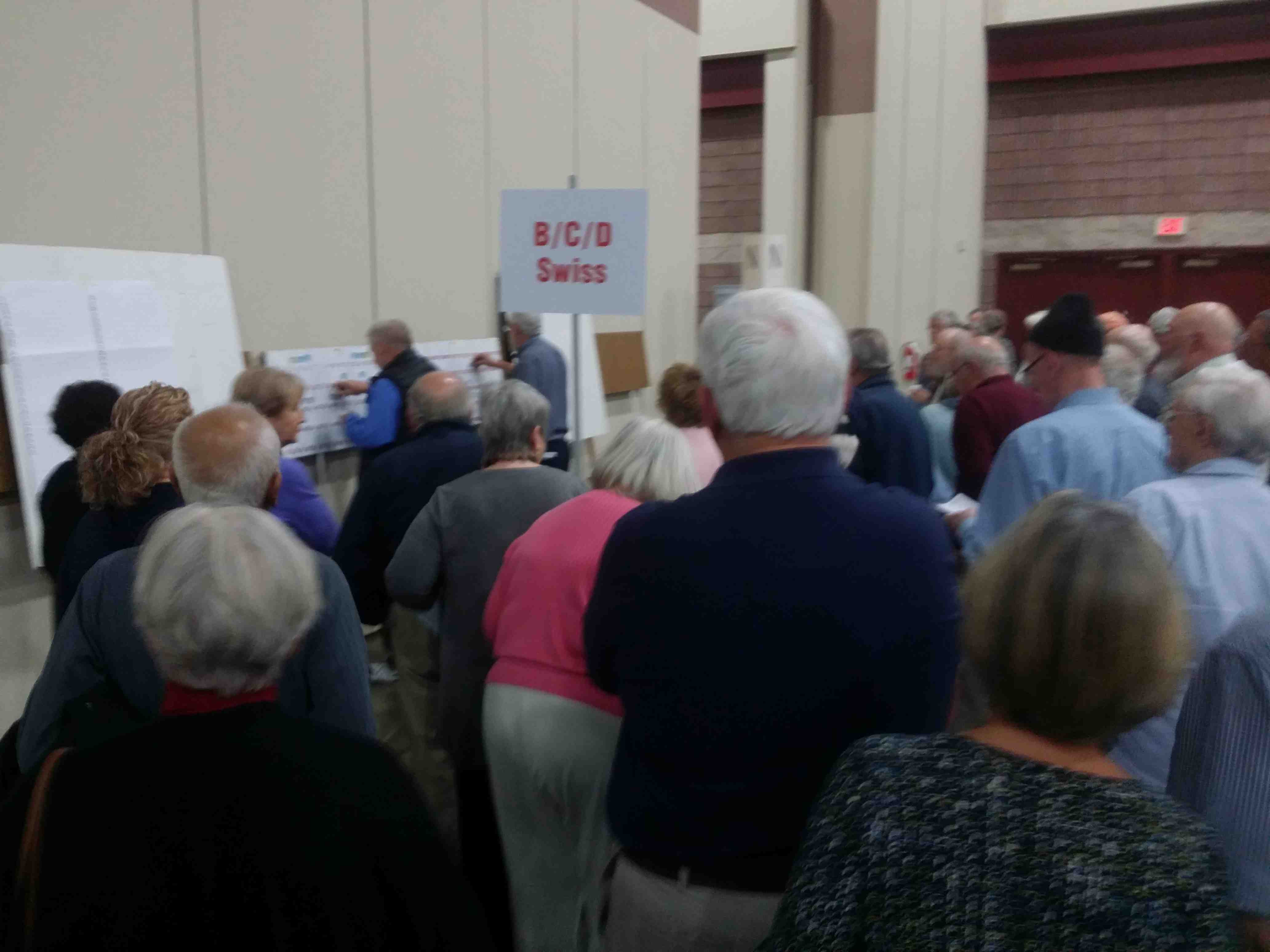
This is ACBLscore running an evening Swiss. Note the crowds trying to find their assignments and the number of directors needed at round change time.
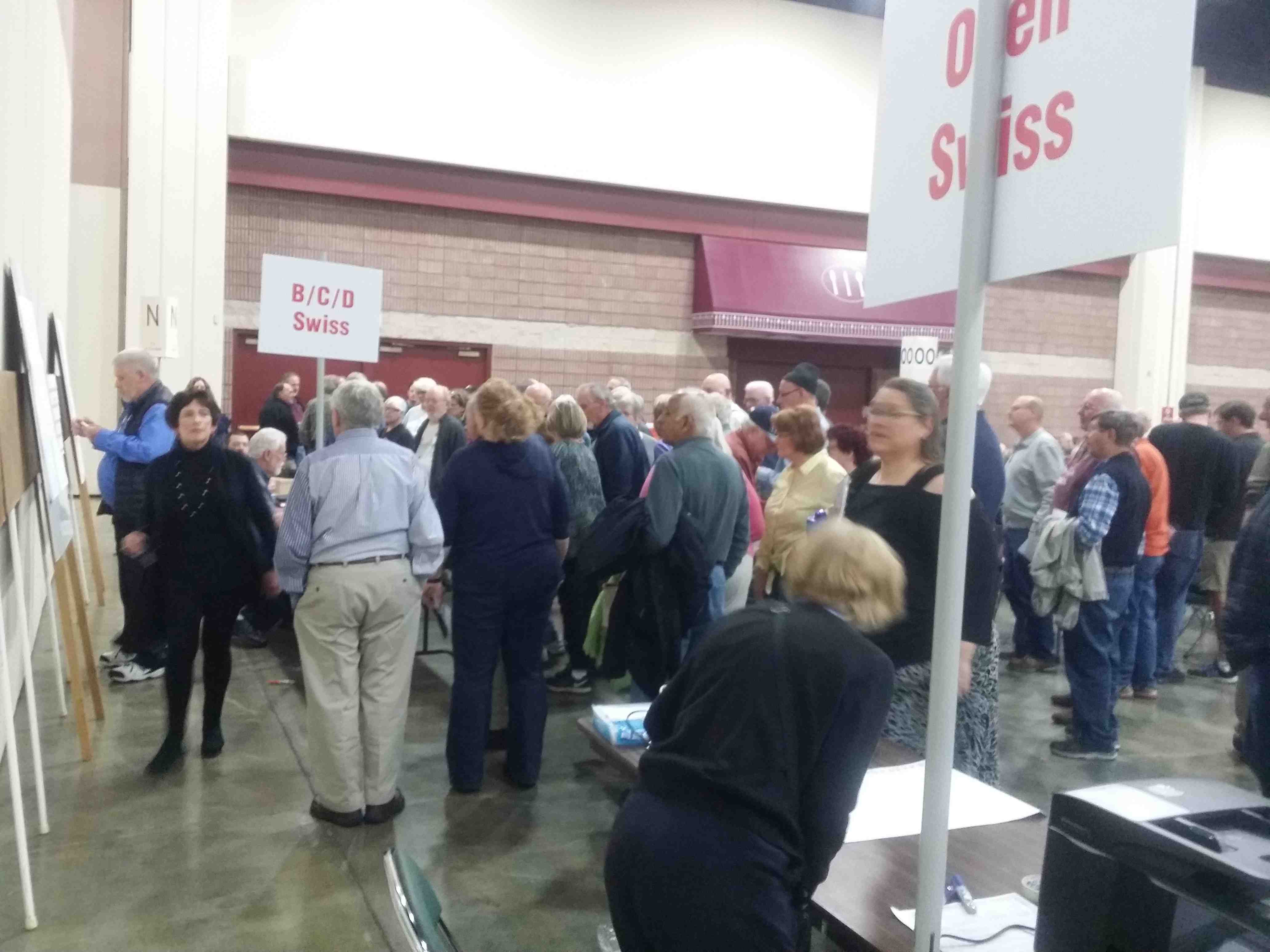
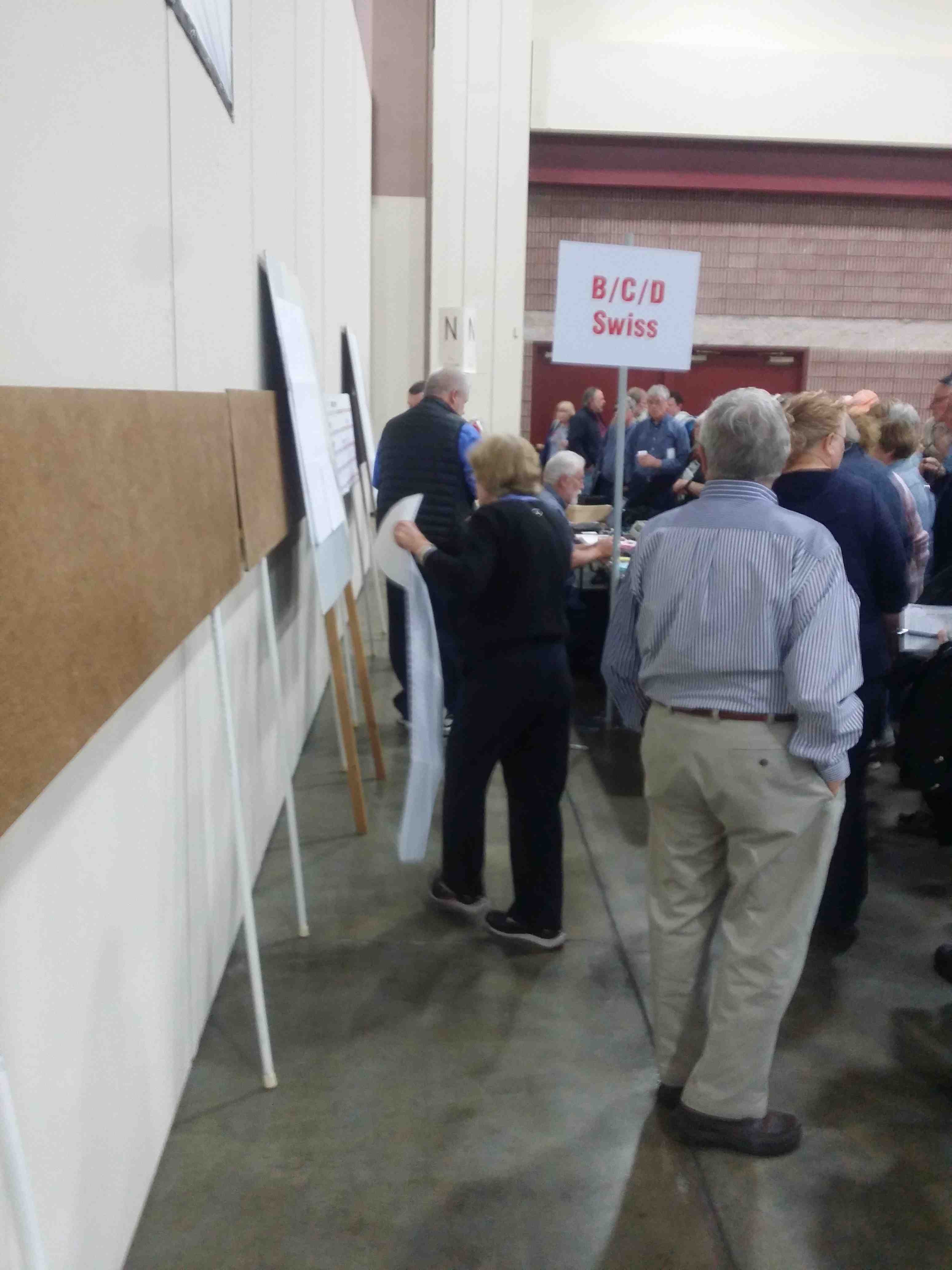
There are 4 directors behind the table entering scores. Bridgescore+ needs 0.
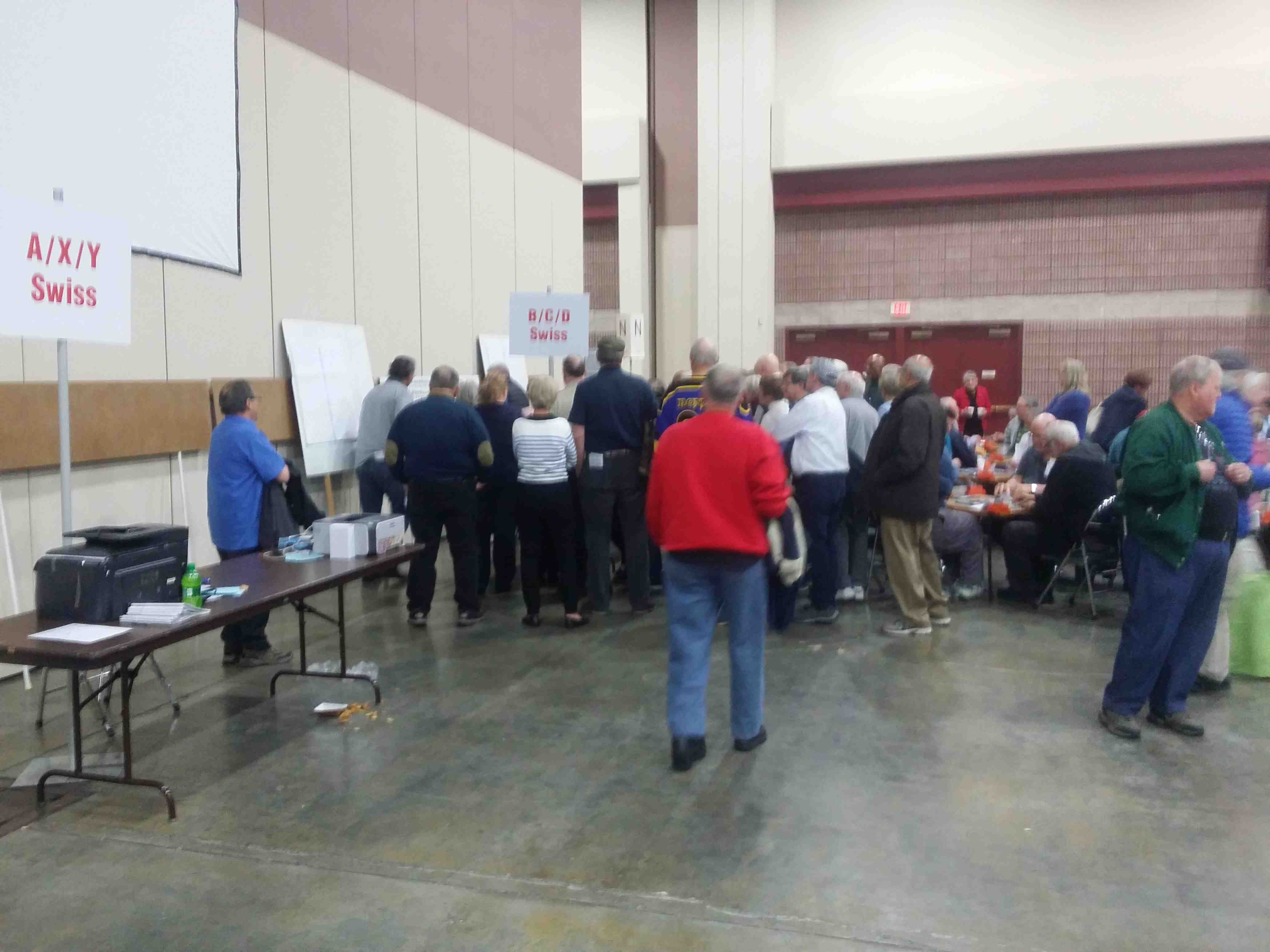
ACBLscore. Taken at 7:54 p.m. Players still waiting for their assignments. Already running behind. The round should have started by 7:48 p.m.
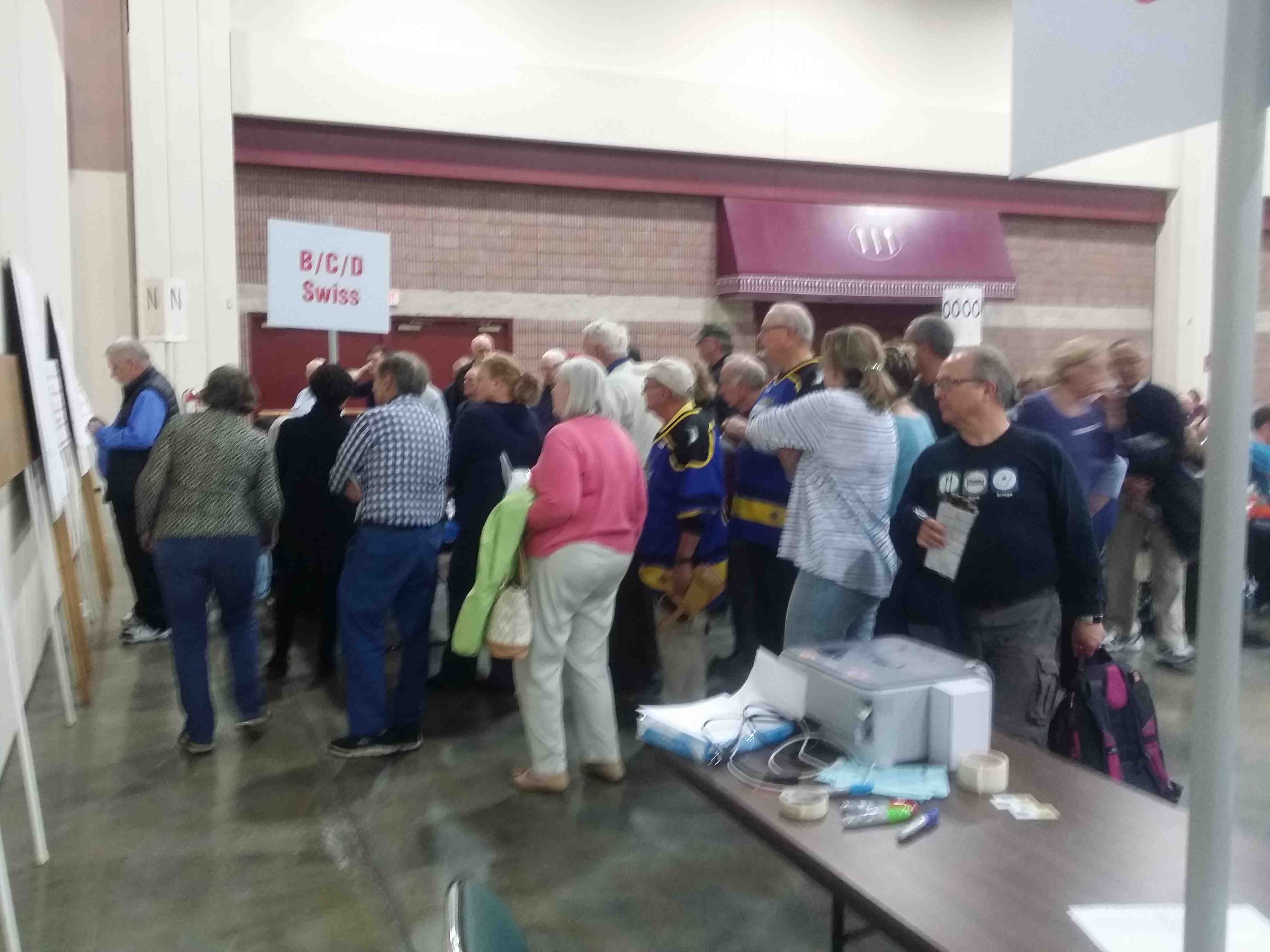
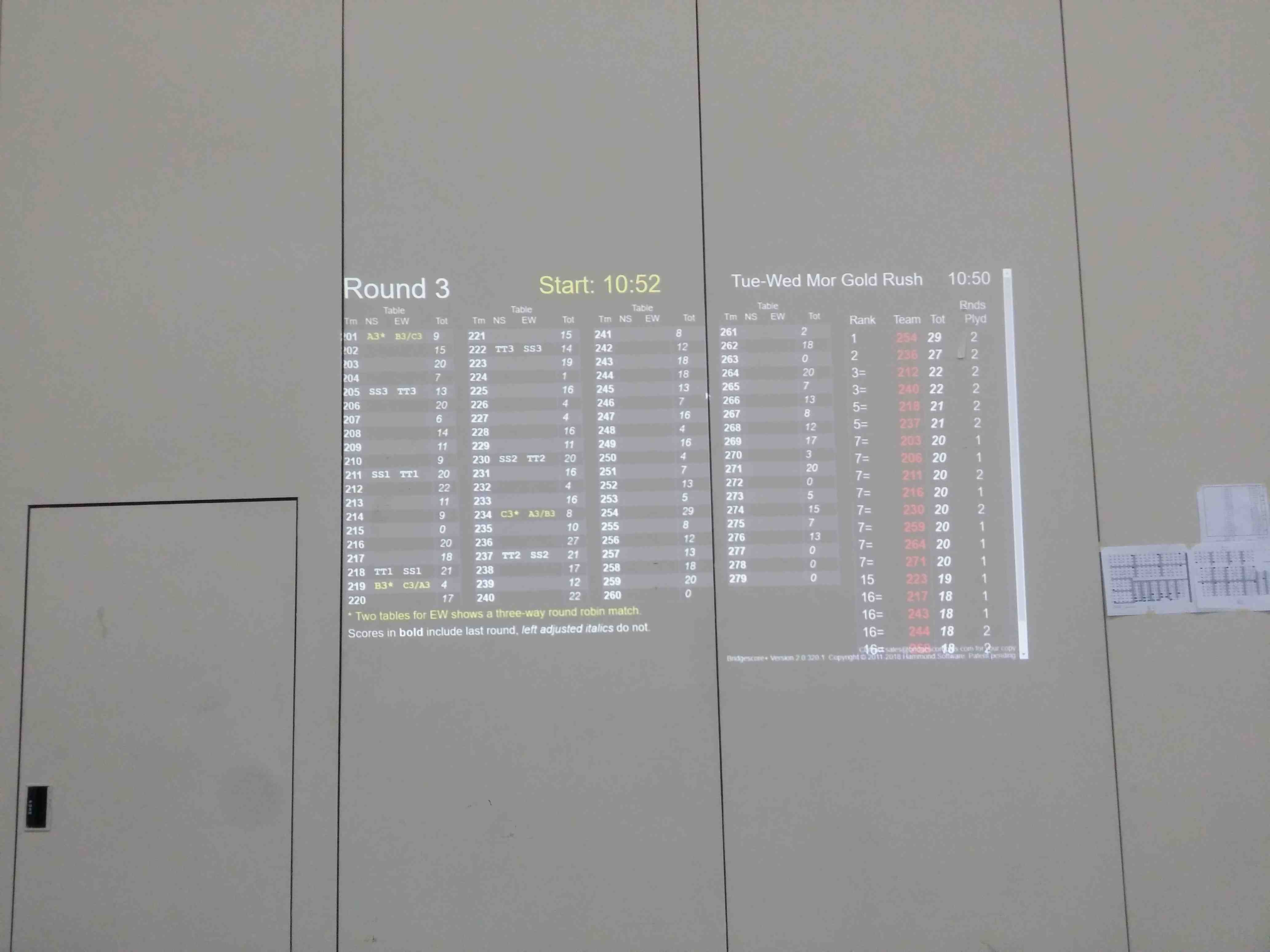
Bridgescore+. 10:50 am. Running on time. Compare to photographs from ACBLscore event.
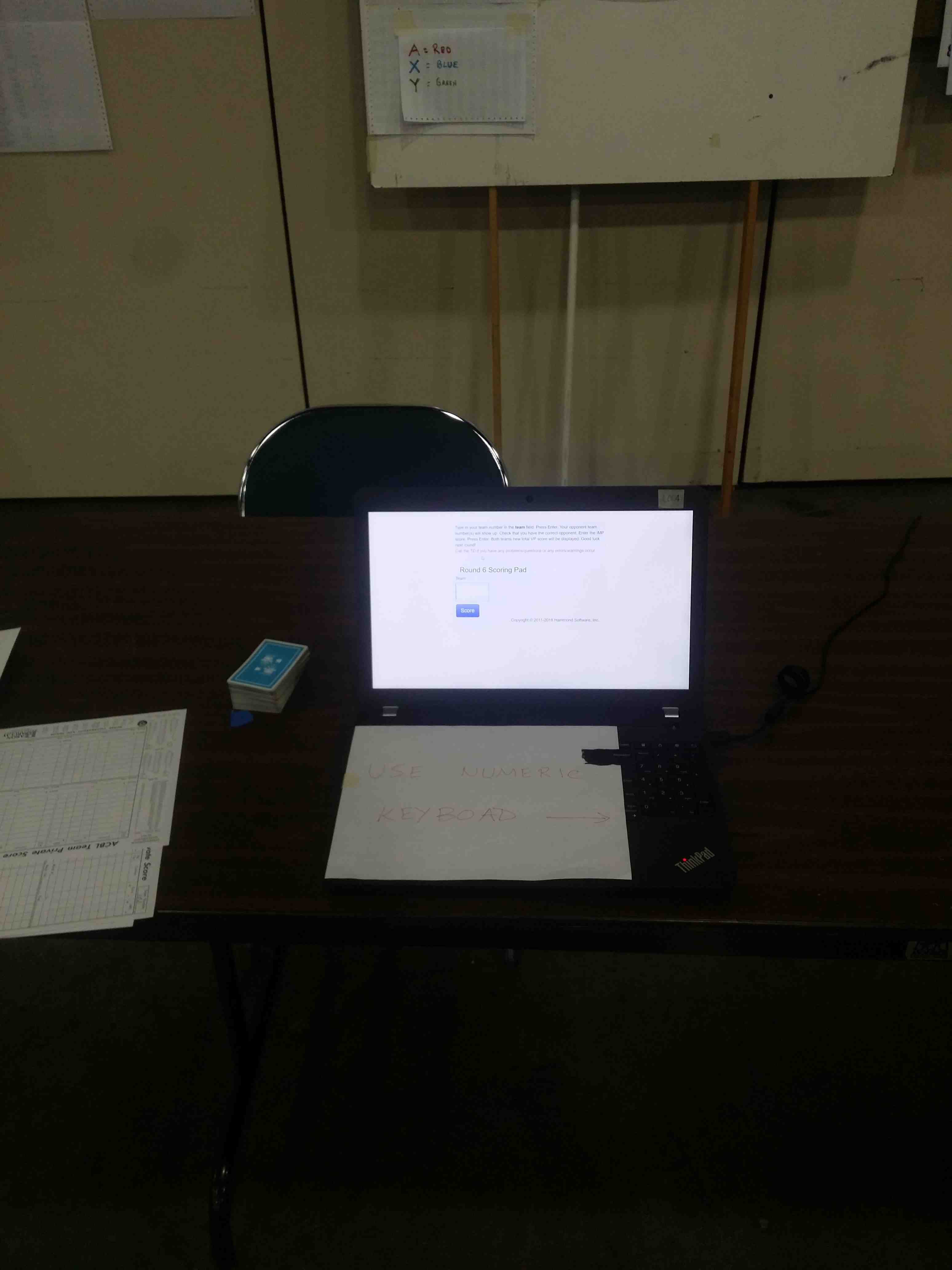
This is the player input screen for Swiss events. Note the expensive keyboard overlay with the Kimberly cut out to allow access to the Backspace key.
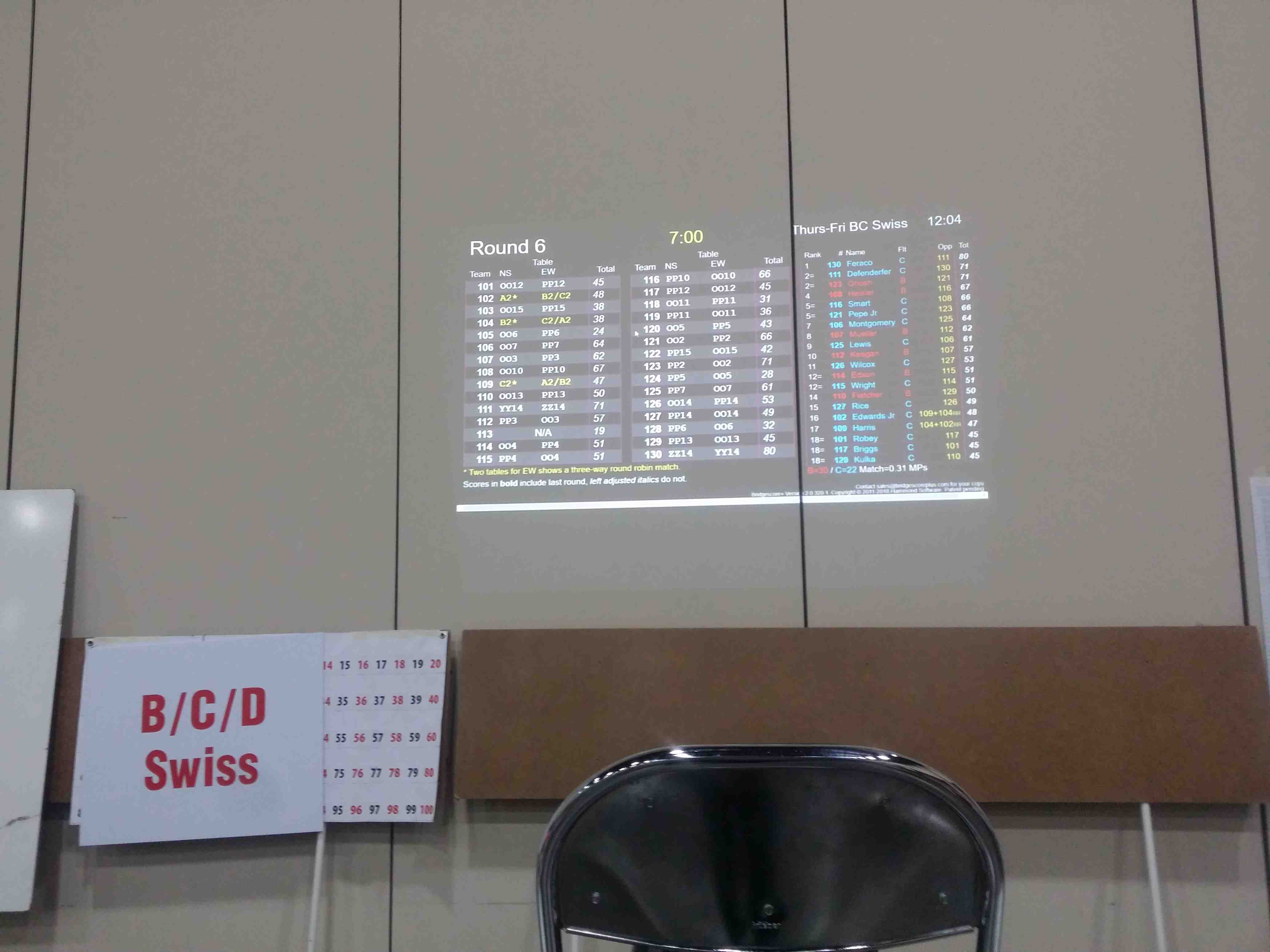
Thursday/Friday BC Swiss showing all teams, their Round 6 assignments, the number of minutes left in the round (7:00) and the current time (12:04). The leader board is on the right of the screen. Teams are shown in different colors (Red=B, Blue=C) based on their strat.
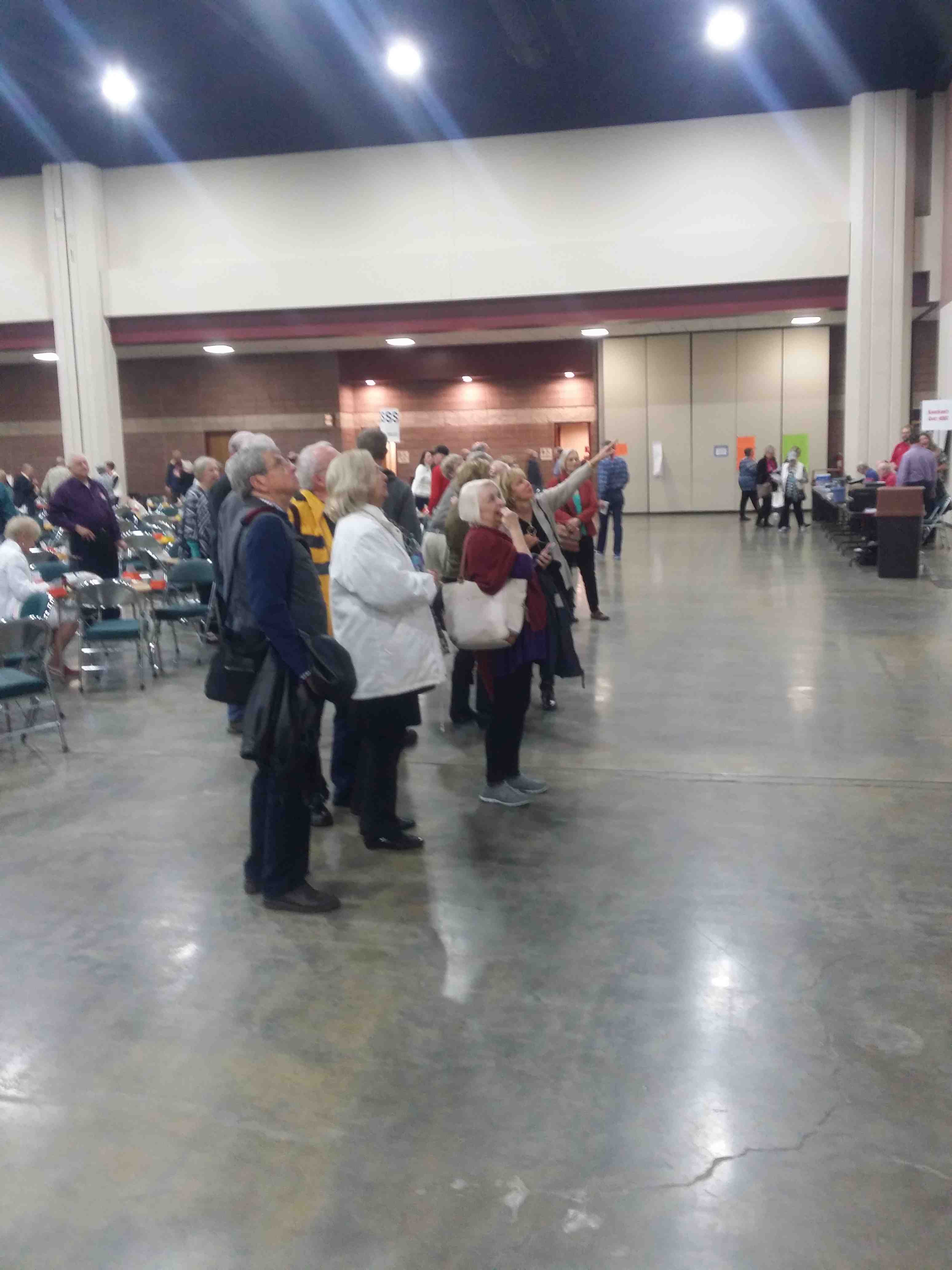
Players checking their results. Note no crowding around the projector.
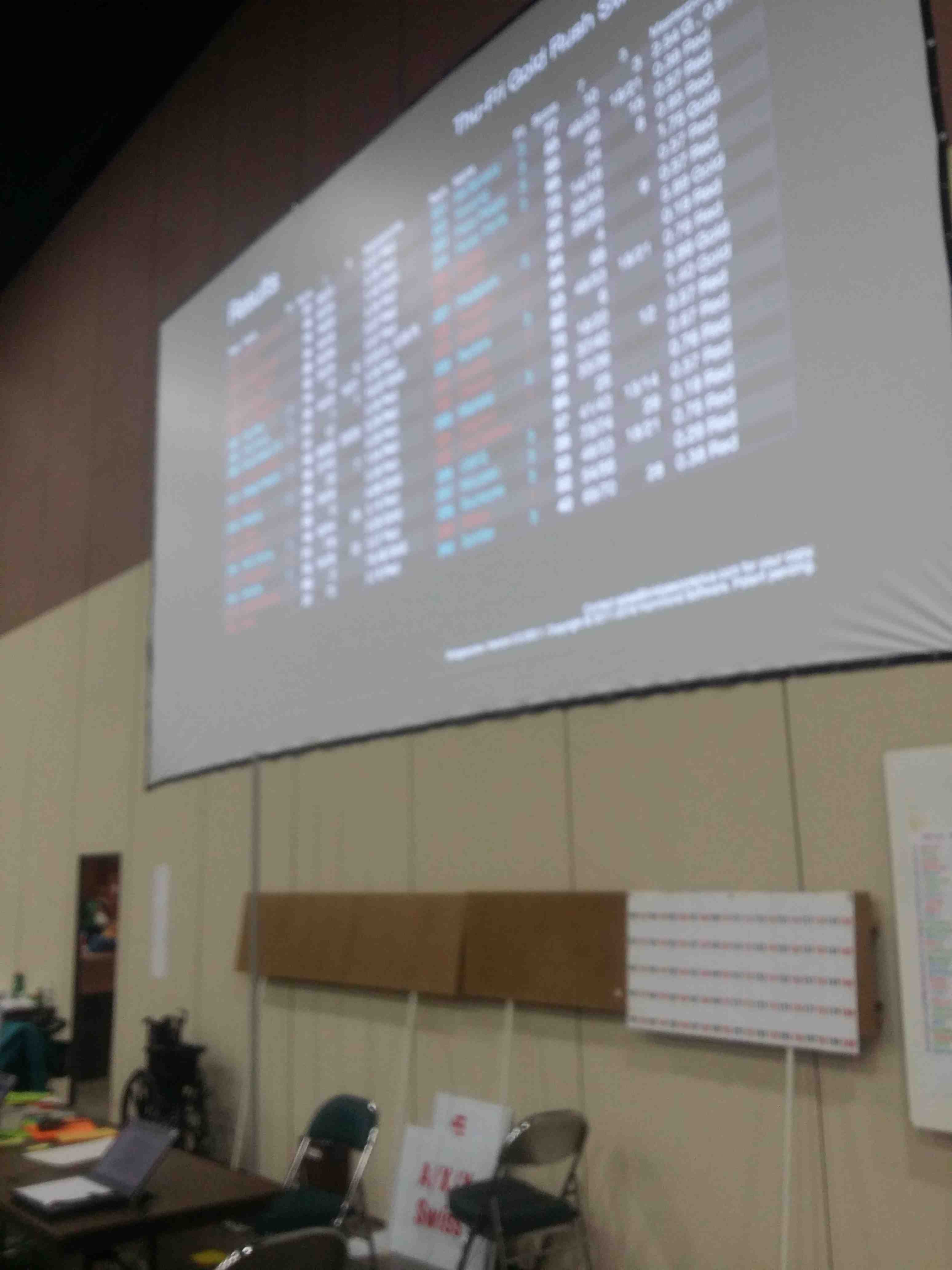
Not a good quality image, but shows the final results with the teams, and the number of masterpoints won and the color.
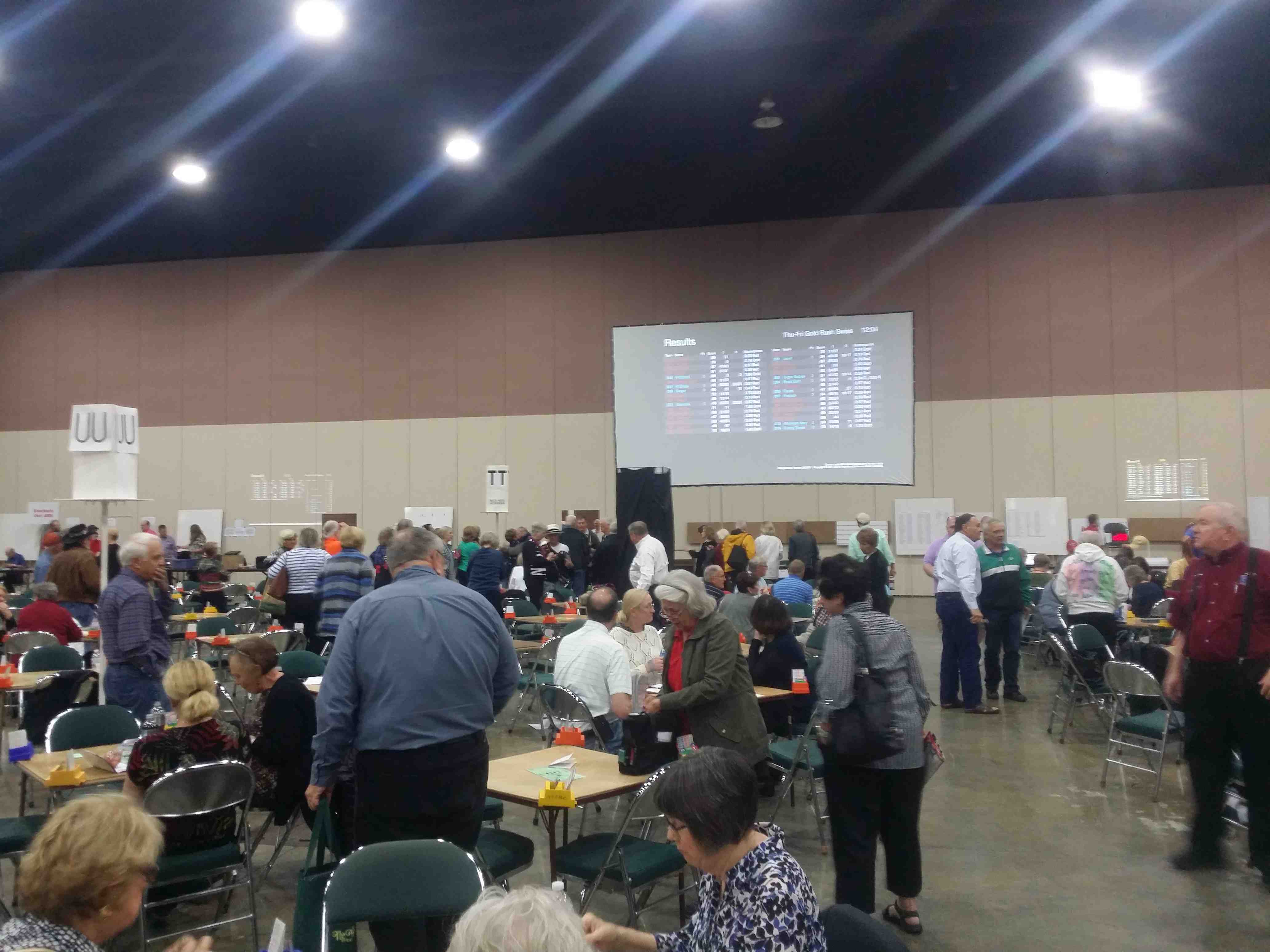
On this picture you can see three concurrent Swiss events - the A/X is on the left, G/R in the middle and B/C on the right. Results are in. The display shows the teams, their numbers and how many masterpoints they won.
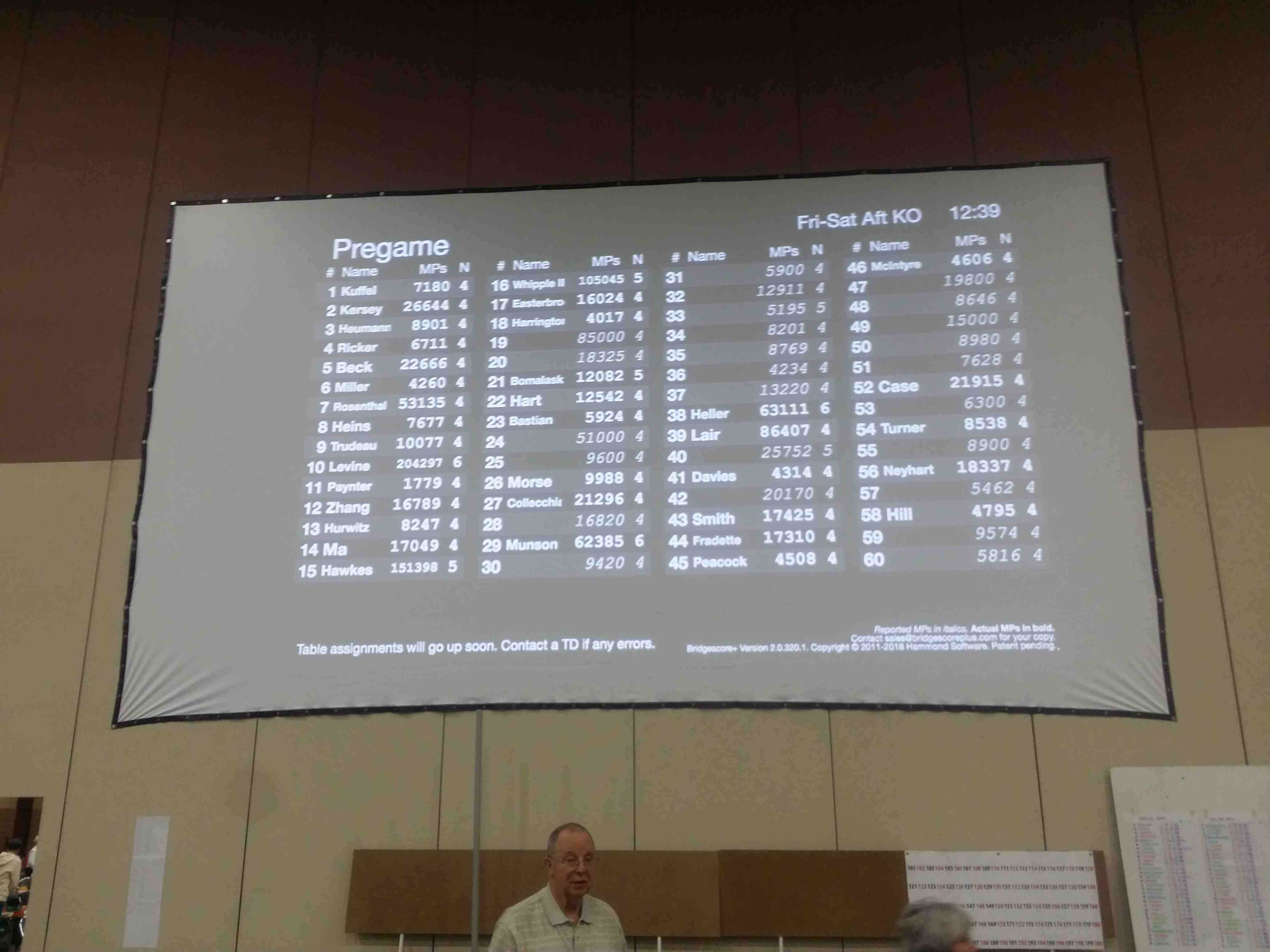
KO sale on Friday. 20 minutes before game time. Teams with a captain's name have used their TID. For those with a TID, we know all the players, we know their exact number of masterpoints.
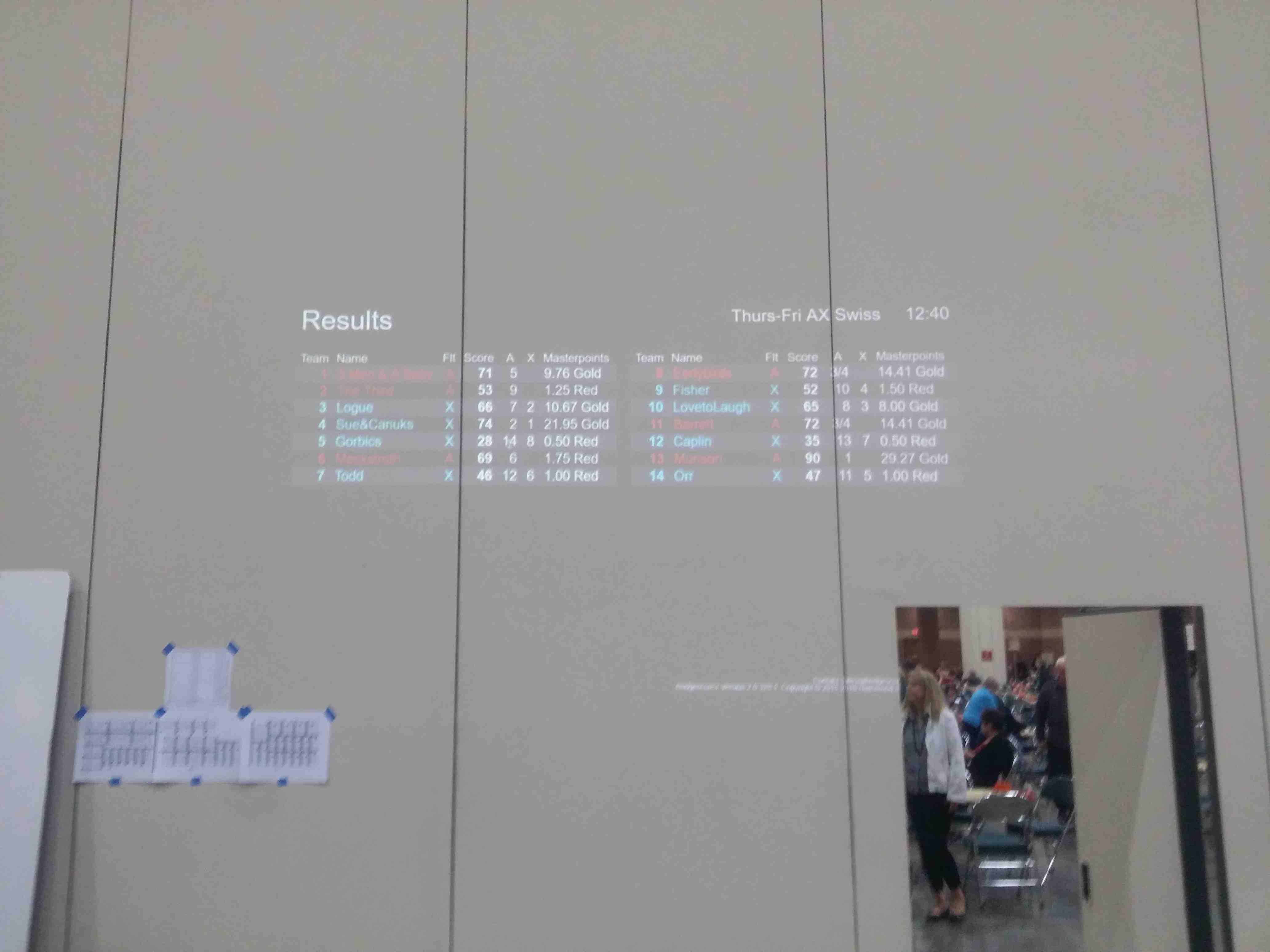
Results from the Thursday-Friday A/X Swiss.
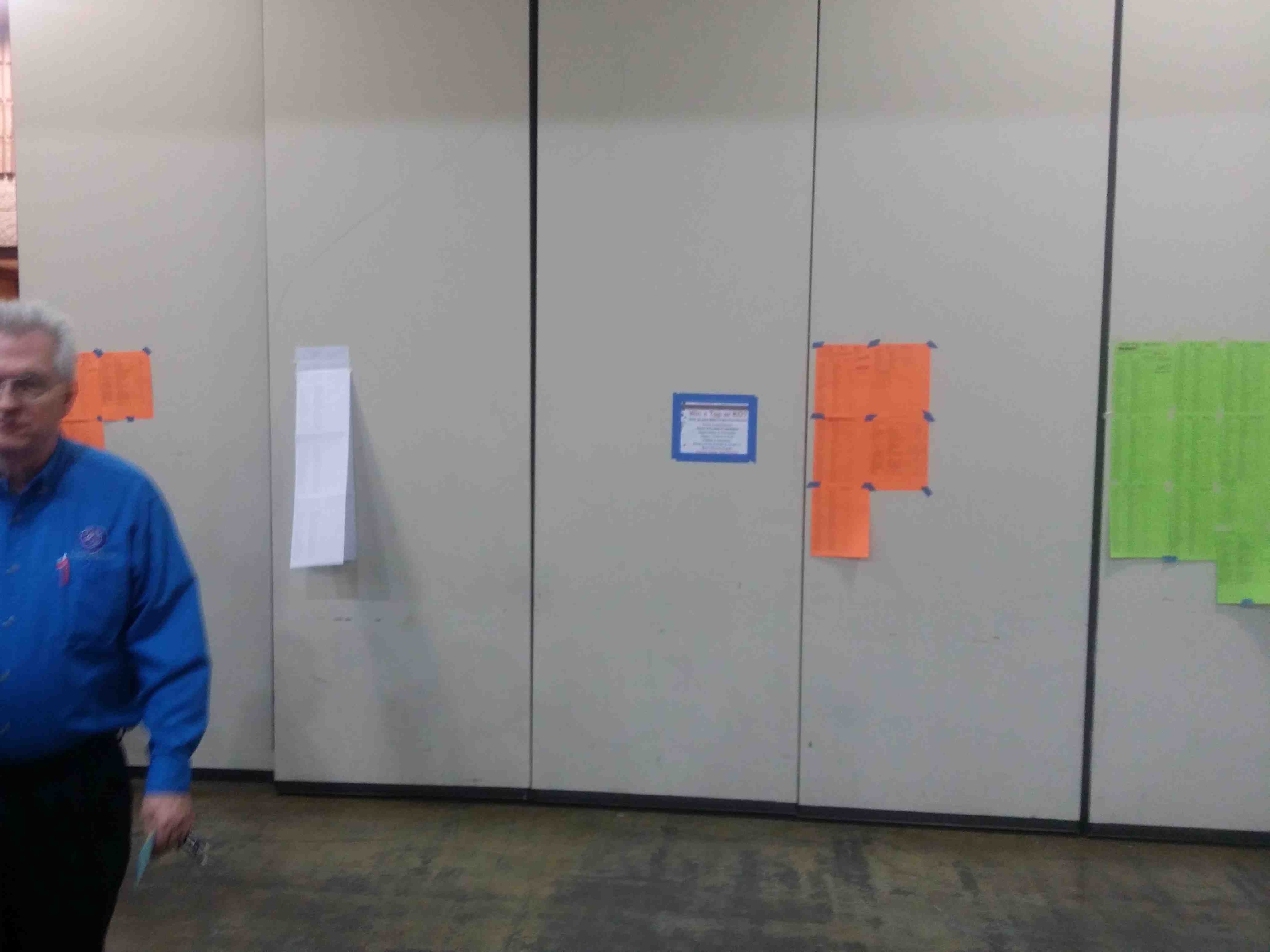
For the Thu-Fri Swiss, we used Bridgescore+ to print out the press sheets, recap sheets and masterpoint charts. ACBLscore no longer can print out the masterpoint chart.